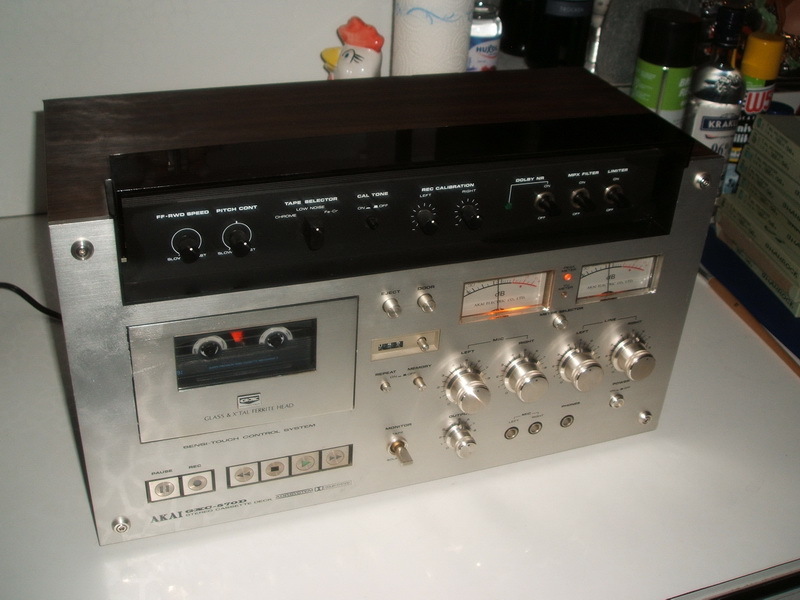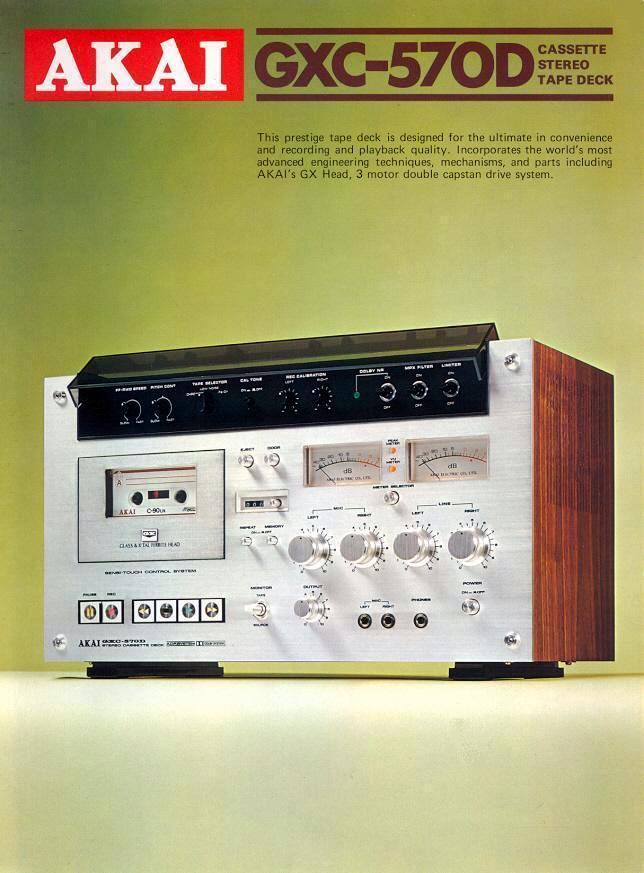Difference between revisions of "Akai GXC-570 E"
m (nicht vorlagenkonform) |
|||
| (14 intermediate revisions by 7 users not shown) | |||
| Line 1: | Line 1: | ||
| − | {{ | + | __NOTOC__ |
| + | == Data == | ||
| + | {{navigation}} | ||
| + | '''General''' | ||
| + | * Manufacturer: [[Akai]] | ||
| + | * Model: GXC-570 D | ||
| + | * Type: Cassette Tape Deck | ||
| + | * Years of manufacture: 1975 - 1979 | ||
| + | * Made in: Japan | ||
| + | * Color: silver, housing real wood | ||
| + | * Remote control: yes, optional, cable remote control RC-17 | ||
| + | * Power consumption: | ||
| + | * Dimensions: 440 x 255 x 225 mm (WxHxD). | ||
| + | * Weight: 13,5 kg | ||
| + | * Original price: 1'998 DM (RRP) | ||
| − | |||
| − | |||
| − | |||
| − | |||
| − | + | '''Connections''' | |
| − | + | * Number of inputs: | |
| − | + | ** Line In 1, 2: 70 mV, 100 kOhm | |
| − | + | Line In DIN: 20 kOhm | |
| + | ** Microphone 1, 2 (2 x 6.3 mm jack): 0.3 mV, 4.7 kOhm | ||
| + | * Number of outputs: | ||
| + | ** Line Out: 410 mV, 0.47 kOhm | ||
| + | Line Out DIN: 410 mV, 0.47 kOhm | ||
| + | ** Headphones (6.3 mm jack): 50 mV, 8 Ohm | ||
| − | |||
| − | |||
| − | |||
| − | + | '''Technical Data:''' | |
| − | + | * track system: 4 track, 2 channel stereo | |
| − | + | * Audio heads: 2 | |
| + | 1x GX-double head for separate recording and playback, 1x erase head | ||
| + | * Motors 3: | ||
| + | ** 1 x double capstan drive with frequency controlled servo motor, 2 DC motors for fast forward and reverse. | ||
| + | * Speed: 4,75 cm/ s | ||
| + | * Synchronous running fluctuations: 0.06 % WRMS, 0.15% (DIN 45500) | ||
| + | * Band types: LN+LH, CrO2, FeCr, (I, II, III) | ||
| + | * Frequency response ± 3 dB: | ||
| + | ** Type I: 30 - 15,000 Hz | ||
| + | Type II: 30 - 16,000 Hz | ||
| + | Type III: 30 - 18,000 Hz | ||
| + | * Signal-to-noise ratio: | ||
| + | ** better than 56 dB (Dolby off). | ||
| + | ** Dolby on: Improvement up to 10 dB above 5,000 Hz. | ||
| + | * Rewind time (C 60): 60 s | ||
| + | * Cancellation attenuation: better than 70 dB | ||
| + | * Premagnetization: 100 khz | ||
| + | * Auto reverse: no | ||
| + | * Title search: no | ||
| + | * Dolby NR: yes, adjustable Dolby | ||
| + | * MPX filter: yes | ||
| + | * Chrome erasure attenuation: 70 dB | ||
| − | + | ||
| − | + | '''Special features:''' | |
| − | + | * Level meter: 2x VU, switchable to peak display | |
| − | + | * Jog keys logic control | |
| + | * Tape counter: 3-digit, mechanical | ||
| + | * Dual-Capstan transport | ||
| + | * Rear band control | ||
| + | * Adjustable Dolby | ||
| + | |||
| + | |||
| + | == Comments == | ||
| + | * Other models in the same series: | ||
| + | * [[Akai GXC-715 D]] | ||
| + | * [[Akai GXC-725 D]] | ||
| + | * [[Akai GXC-735 D]] | ||
| + | * [[Akai GXC-750 D]] | ||
| + | * [[Akai GXC-760 D]] | ||
| + | * [[Akai GXC-570 D]] | ||
| + | |||
| + | |||
| + | == Pictures == | ||
| + | * Image: Akai GXC-570 D | ||
| + | [[File:Akai GXC 570 D.jpg]] | ||
| + | |||
| + | |||
| + | * Excerpt from brochure: Akai GXC-570 D | ||
| + | [[File:Akai GXC-570 D-Prospekt-1.jpg]] | ||
| + | |||
| + | |||
| + | == Reports == | ||
| + | * Report 1 at "Good Old Hifi": [[http://www.good-old-hifi.de/akai_gxc-570d/]] | ||
| + | |||
| + | * Report 2 at "Good Old Hifi": [[http://www.good-old-hifi.de/akai_gxc-570d-2/]] | ||
| + | |||
| + | |||
| + | == Links == | ||
| + | * External link to website "The Vintage Knob": [[http://www.thevintageknob.org/akai-GXC-570D.html]] | ||
| + | |||
| + | |||
| + | [[Category:Cassette Decks]] | ||
Latest revision as of 09:58, 17 May 2019
Data
General
- Manufacturer: Akai
- Model: GXC-570 D
- Type: Cassette Tape Deck
- Years of manufacture: 1975 - 1979
- Made in: Japan
- Color: silver, housing real wood
- Remote control: yes, optional, cable remote control RC-17
- Power consumption:
- Dimensions: 440 x 255 x 225 mm (WxHxD).
- Weight: 13,5 kg
- Original price: 1'998 DM (RRP)
Connections
- Number of inputs:
- Line In 1, 2: 70 mV, 100 kOhm
Line In DIN: 20 kOhm
- Microphone 1, 2 (2 x 6.3 mm jack): 0.3 mV, 4.7 kOhm
- Number of outputs:
- Line Out: 410 mV, 0.47 kOhm
Line Out DIN: 410 mV, 0.47 kOhm
- Headphones (6.3 mm jack): 50 mV, 8 Ohm
Technical Data:
- track system: 4 track, 2 channel stereo
- Audio heads: 2
1x GX-double head for separate recording and playback, 1x erase head
- Motors 3:
- 1 x double capstan drive with frequency controlled servo motor, 2 DC motors for fast forward and reverse.
- Speed: 4,75 cm/ s
- Synchronous running fluctuations: 0.06 % WRMS, 0.15% (DIN 45500)
- Band types: LN+LH, CrO2, FeCr, (I, II, III)
- Frequency response ± 3 dB:
- Type I: 30 - 15,000 Hz
Type II: 30 - 16,000 Hz Type III: 30 - 18,000 Hz
- Signal-to-noise ratio:
- better than 56 dB (Dolby off).
- Dolby on: Improvement up to 10 dB above 5,000 Hz.
- Rewind time (C 60): 60 s
- Cancellation attenuation: better than 70 dB
- Premagnetization: 100 khz
- Auto reverse: no
- Title search: no
- Dolby NR: yes, adjustable Dolby
- MPX filter: yes
- Chrome erasure attenuation: 70 dB
Special features:
- Level meter: 2x VU, switchable to peak display
- Jog keys logic control
- Tape counter: 3-digit, mechanical
- Dual-Capstan transport
- Rear band control
- Adjustable Dolby
Comments
- Other models in the same series:
- Akai GXC-715 D
- Akai GXC-725 D
- Akai GXC-735 D
- Akai GXC-750 D
- Akai GXC-760 D
- Akai GXC-570 D
Pictures
- Image: Akai GXC-570 D
- Excerpt from brochure: Akai GXC-570 D
Reports
- Report 1 at "Good Old Hifi": [[1]]
- Report 2 at "Good Old Hifi": [[2]]
Links
- External link to website "The Vintage Knob": [[3]]

